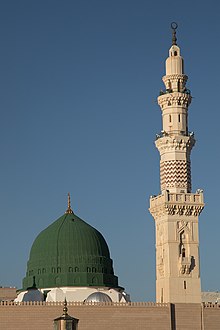| Green Dome | |
|---|---|
Al-Qubbah Al-Khaḍrāʾ (ٱَلْقُبَّة ٱلْخَضْرَاء) | |
 The Green Dome at the Prophet's Mosque and the Bab Al-Baqi' minaret | |
| Religion | |
| Affiliation | Islam |
| Region | Al-Madinah Province |
| Rite | Ziyarat |
| Leadership | President of the Affairs of the Two Holy Mosques: Abdul Rahman Al-Sudais |
| Location | |
| Location | Al-Masjid an-Nabawi, Medina, Hejaz, Saudi Arabia |
| Administration | The Agency of the General Presidency for the Affairs of the Two Holy Mosques |
| Geographic coordinates | 24°28′03.22″N 039°36′41.18″E / 24.4675611°N 39.6114389°E |
| Architecture | |
| Type | Tomb |
| Founder | Mamluk Sultan Al Mansur Qalawun[1] |
| Date established | 678 A.H. / 1279 C.E.[2][1] |
| Completed | 678 A.H. / 1279 C.E.[2][1] |
| Materials | Wood,[3] brick[4] |
The Green Dome (Arabic: ٱَلْقُبَّة ٱلْخَضْرَاء, romanized: al-Qubbah al-Khaḍrāʾ, Hejazi Arabic pronunciation: [al.ɡʊb.ba al.xadˤ.ra]) is a green-coloured dome built above the tombs of the Islamic prophet Muhammad and the early Rashidun Caliphs Abu Bakr (r. 632–634) and Omar (r. 634–644), which used to be the Noble Chamber of Aisha. The dome is located in the southeast corner of Al-Masjid al-Nabawi in Medina, present-day Saudi Arabia.[5] Millions visit it every year, since it is a tradition to visit the mosque after or before the pilgrimage to Mecca.
The structure dates back to 1279 C.E., when an unpainted wooden cupola was built over the tomb. It was later rebuilt and painted using different colours (blue and silver) twice in the late 15th century and once in 1817. The dome was first painted green in 1837, and hence became known as the "Green Dome".[2]
- ^ a b c Cite error: The named reference
archnetwas invoked but never defined (see the help page). - ^ a b c Ariffin, Syed Ahmad Iskandar Syed (2005). Architectural Conservation in Islam: Case Study of the Prophet's Mosque. Penerbit UTM. pp. 88–89, 109. ISBN 978-9835203732.
- ^ Cite error: The named reference
peacewas invoked but never defined (see the help page). - ^ Cite error: The named reference
Meinecke1993was invoked but never defined (see the help page). - ^ Petersen, Andrew (2002). Dictionary of Islamic Architecture. Routledge. p. 183. ISBN 978-0203203873.


